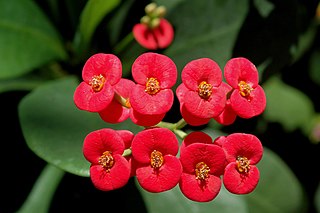
Euphorbia milii, the crown of thorns, Christ plant, or Christ thorn, is a species of flowering plant in the spurge family Euphorbiaceae, native to Madagascar. The species name commemorates Baron Milius, once Governor of Réunion, who introduced the species to France in 1821. It is imagined that the species was introduced to the Middle East in ancient times, and legend associates it with the crown of thorns worn by Christ. It is commonly used as an ornamental houseplant that can be grown in warmer climates. The common name is due to the thorns and deep red bracts referring to the crown thorn Jesus had to wear during his crucifixion and his blood.

Euphorbia bourgaeana is a species of flowering plant in the spurge family Euphorbiaceae. It is native to Tenerife in the Canary Islands.
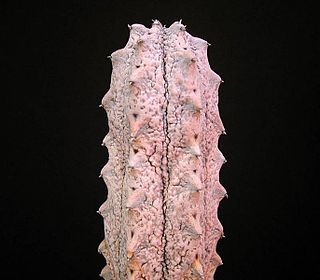
Euphorbia abdelkuri is a species of plant in the family Euphorbiaceae. It is endemic to Abd al Kuri, an island south of Yemen. Its natural habitat is rocky areas. The Latex of the plant is toxic.
Euphorbia alcicornis is a species of plant in the family Euphorbiaceae. It is endemic to Madagascar. Its natural habitat is rocky areas. It is threatened by habitat loss.
Euphorbia analalavensis is a species of plant in the family Euphorbiaceae. It is native to northern and western Madagascar and the Comoro Islands. Its natural habitat is dry deciduous forest and rocky areas between 50 and 400 meters elevation. It is threatened by habitat loss.

Euphorbia antso is a species of plant in the family Euphorbiaceae. It is endemic to Madagascar. Its natural habitat is subtropical or tropical dry shrubland. It is threatened by habitat loss.

Euphorbia arahaka is a species of plant in the family Euphorbiaceae. It is endemic to Madagascar. Its natural habitats are subtropical or tropical dry forests, subtropical or tropical dry shrubland, and sandy shores. It is threatened by habitat loss.
Euphorbia boivinii is a species of plant in the family Euphorbiaceae. It is endemic to Madagascar. Its natural habitat is subtropical or tropical moist lowland forests. It is threatened by habitat loss.
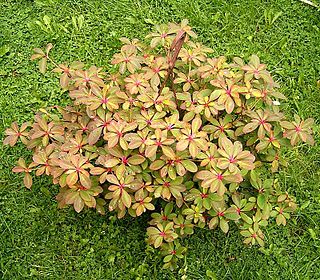
Euphorbia bongolavensis is a species of plant in the family Euphorbiaceae. It is endemic to Madagascar. Its natural habitat is subtropical or tropical dry forests. It is currently being threatened by habitat loss.
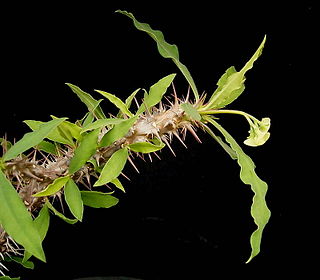
Euphorbia capuronii is a species of plant in the family Euphorbiaceae. It is endemic to Madagascar. It is threatened by habitat loss.

Euphorbia elliotii is a species of plant in the family Euphorbiaceae. It is endemic to Madagascar. It is threatened by habitat loss.

Euphorbia enterophora is a species of plant in the family Euphorbiaceae. It is endemic to Madagascar. Its natural habitats are subtropical or tropical dry forests and rocky areas. It is threatened by habitat loss.

Euphorbia fiherenensis is a species of plant in the family Euphorbiaceae. It is endemic to Madagascar. Its natural habitats are subtropical or tropical dry forests, subtropical or tropical dry shrubland, and rocky areas. It is threatened by habitat loss.

Euphorbia francoisii is a species of plant in the family Euphorbiaceae. It is endemic to Madagascar. Its natural habitats are subtropical or tropical dry forests and subtropical or tropical dry shrubland. It is threatened by habitat loss. The species is used as ornamental plant and colourful cultivars have been bred, specially by the Thai breeder Mr. Santiporn Sangchai.
Euphorbia mandravioky is a species of plant in the family Euphorbiaceae. It is endemic to Madagascar. Its natural habitats are subtropical or tropical dry forests and rocky areas. It is threatened by habitat loss.
Euphorbia pachysantha is a species of plant in the family Euphorbiaceae. It is endemic to Madagascar. Its natural habitats are subtropical or tropical moist lowland forests and subtropical or tropical moist montane forests. It is threatened by habitat loss.
Euphorbia physoclada is a species of plant in the family Euphorbiaceae. It is endemic to Madagascar. Its natural habitat is subtropical or tropical dry forests. It is threatened by habitat loss.
Euphorbia quitensis is a species of plant in the family Euphorbiaceae. It is endemic to Ecuador. Its natural habitat is subtropical or tropical moist montane forests.
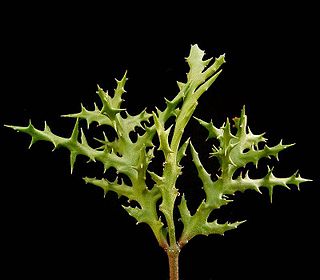
Euphorbia stenoclada is a species of plant in the family Euphorbiaceae. It is native to Madagascar and the Mozambique Channel Islands. Its natural habitats are subtropical or tropical dry forests, subtropical or tropical dry shrubland, and rocky areas. It is threatened by habitat loss.
Euphorbia remyi is a rare species of flowering plant in the family Euphorbiaceae. It is known by the common name Remy's sandmat locally as ʻakoko. It is endemic to the island of Kauaʻi in Hawaii, where it grows in mixed mesic forests, wet forests and bogs from 150 to 900 m.













